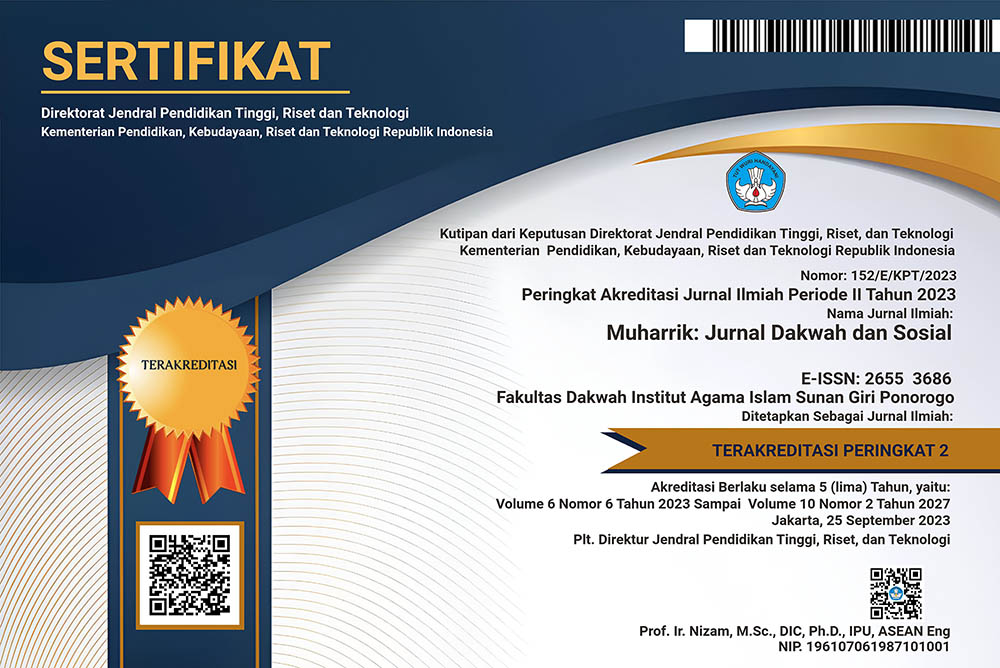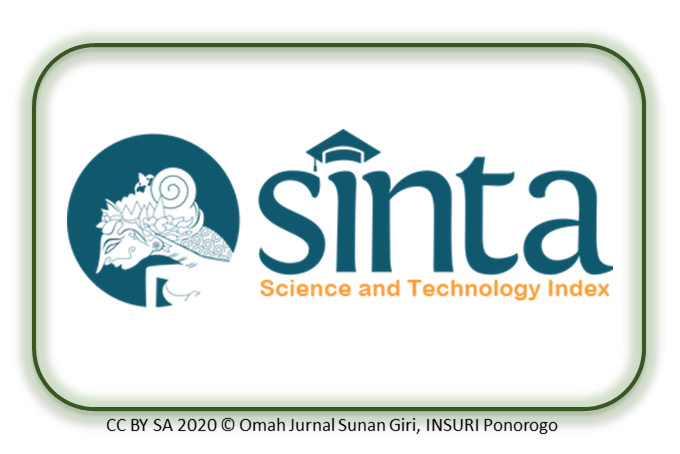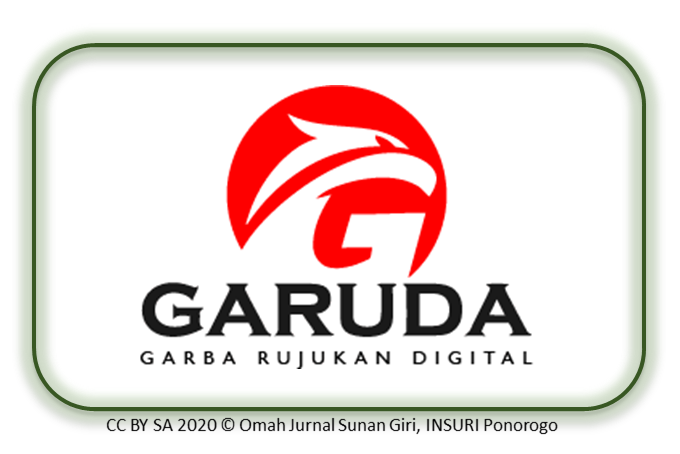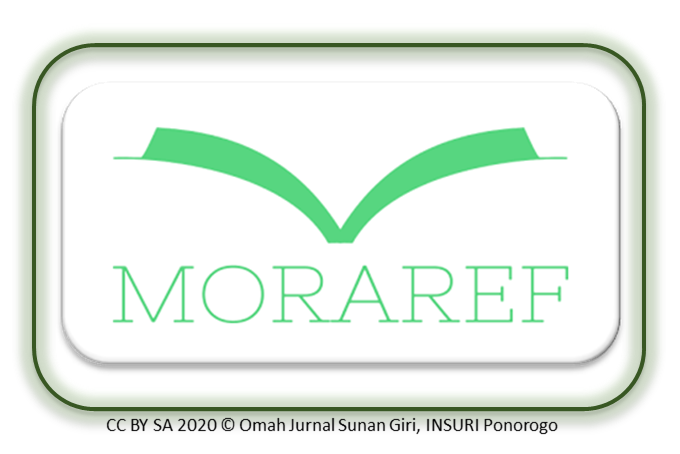Stigma, Religion, and Collective Identity: The Transformation of Former Thugs in Solo
DOI:
https://doi.org/10.37680/muharrik.v7i1.7989Keywords:
Navigation identity , Former thugs , interaction socialAbstract
This study argues that the former thugs make an effort to rehabilitate their spoiled identity into a new identity collectively by presenting themselves on the front stage with a religious background. The former thugs change their appearance, spiritual behavior, ideological views, and economic management to create a new impression. This study employs a qualitative research approach with a phenomenological perspective. Data collection techniques include in-depth interviews, observation, and documentation. Data analysis techniques consist of three stages: data reduction, data presentation, and conclusion. This study asks what the former thugs behave in the front stage? How do they navigate their identity to remove the stigma? This study finds that to navigate their identity, former thugs join the Islamic group, they change their nickname to a good nickname that shows their Islamic identity, they use their wealth to support religious activities and use it for something that is in accordance with Islamic teachings. They make these changes with their friends in the Islamic group collectively. This study incorporates Erving Goffman's theory, which posits that people in the West who have spoiled identities navigate their identities individually. In contrast, former thugs in Solo navigate their collective identity.
Downloads
References
Achmad Fadhli (Direktur). (2015, Juli 14). Pesantrenku Tak Beratap | Documentary Films [Video recording]. https://www.youtube.com/watch?v=qBPOIw5pa-c
Ahyar, M. (2015). Membaca Gerakan Islam Radikal Dan Deradikalisasi Gerakan Islam. Walisongo: Jurnal Penelitian Sosial Keagamaan, 23(1), Article 1. https://doi.org/10.21580/ws.23.1.220
Bakker, L. (2021). Gangster or social bandit?. Rise and fall of an Indonesian preman. Terrain. Anthropologie & sciences humaines, 74. https://doi.org/doi.org/10.4000/terrain.21364.
Bram, D. (2023). Disebut Mantan Preman, Rudy: Nyat Ho’o - Radar Solo. Disebut Mantan Preman, Rudy: Nyat Ho’o - Radar Solo. https://radarsolo.jawapos.com/solo/841696961/disebut-mantan-preman-rudy-nyat-hoo
Bullingham, L., & Vasconcelos, A. C. (2013). ‘The presentation of self in the online world’: Goffman and the study of online identities. Journal of Information Science, 39(1), 101–112. https://doi.org/10.1177/0165551512470051
Douglas Wilson, I. (2006). Continuity and change: The changing contours of organized violence in post–New Order Indonesia. Critical Asian Studies, 38(2), 265–297.
Eks, S. (2023, April 4). [Komunikasi pribadi].
Fakhruddin, M., Mu’inuddinillah Basri, M. A., & Rosyadi, I. (2021). Praktik Jual Beli Motor Kredit Macet Dalam Perspektif Imam Mazhab Empat (Studi Kasus Laskar Islam Di Surakarta) [PhD Thesis]. Universitas Muhammadiyah Surakarta.
Farid, A. (2001). Kiat Menjadi Hamba Pilihan Menurut Ulama Salafush Shalih, Terj. Wawan Djunaedi Soffandi. Pustaka Azzam.
Goffman, E. (1956). The presentation of self in everyday life. University of Edinburgh.
Goffman, E. (1990). Stigma: Notes on the management of spoiled identity. Penguin Books.
Harahap, F. R. (2013). Dampak urbanisasi bagi perkembangan kota di Indonesia. Society, 1(1), 35–45. https://doi.org/10.33019/society.v1i1.40
Ibnu Katsir, M. (1997). Tafsir Ibnu Katsir (Pertama, Vol. 4). Darul Fikr.
Jati, W. R. (2012). Kuasa dan Kekerasan: Kelembagaan Premanisme Yogyakarta Paska Reformasi. The Sociology of Islam, 2(1). https://doi.org/10.15642/jsi.2012.2.1.%25p
JIhad, P. of. (2008, Maret 19). Umat Islam Vs Preman, 2 Tewas. Arrahmah.id. https://www.arrahmah.id/umat-islam-vs-preman-2-tewas/
Kafid, N. (2016). Dari Islamisme ke “Premanisme”: Pergeseran Orientasi Gerakan Kelompok Islam Radikal Di Era Desentralisasi Demokrasi. Masyarakat, Jurnal Sosiologi, 21(1). https://scholarhub.ui.ac.id/mjs/vol21/iss1/4
Kapolri Ancam Copot Kapolda yang Gagal Berantas Judi. (t.t.). Diambil 10 Desember 2024, dari https://news.detik.com/berita/d-401134/kapolri-ancam-copot-kapolda-yang-gagal-berantas-judi
Kurniawan. (2020, September 2). Bukan Gondhez’s, Ternyata Inilah Geng Tertua di Kota Solo. Espos Indonesia. https://solopos.espos.id/bukan-gondhezs-ternyata-inilah-geng-tertua-di-kota-solo-1078919
Kurniawan. (2024, Mei 14). Singo Lawu, Bisnis yang Membesarkan Nama Gondhez’s Jadi Geng Berbahaya di Solo. Espos Indonesia. https://solopos.espos.id/singo-lawu-bisnis-yang-membesarkan-nama-gondhezs-jadi-geng-berbahaya-di-solo-1920918
Laskar, K. (2024, Mei). Kisah Hijrah [Komunikasi pribadi].
Masaaki, O., & Hamid, A. (2008). Jawara in Power, 1999—2007. Indonesia, 86, 109–138. http://www.jstor.org/stable/40376462
Masduki, S. (2003). Layanan Bimbingan Konseling di Sekolah. Muhammadiyah University Press.
Napiter, E. (2023, April 28). Pemerasan [Komunikasi pribadi].
Nasional, P. B. D. P. (2008). Kamus Besar Bahasa Indonesia ISBN 978-979-689-779-1. Jakarta: Departemen Pendidikan Nasional.
Noor, I. (2016). Identitas Agama, Ruang Publik Dan Post-Sekularisme: Perspektif Diskursus Jurgen Habermas. Jurnal Ilmiah Ilmu Ushuluddin, 11(1), 61–87.
Pranoto, S. W. (2010). Jawa: Bandit-bandit pedesaan: studi historis, 1850-1942. Graha Ilmu.
Pribadi, Y. (2015). The Historical Roots and Identities of Local Strongmen Groups in Indonesia. Kawalu: Journal of Local Culture, 2(1), 101–144. https://doi.org/doi.org/10.32678/kawalu.v2i1.714.
Purwawidada, F. (2014). Jaringan Baru Teroris Solo. Kepustakaan Populer Gramedia.
Saputro, A. (2020). Urban Crisis Produk Kegagalan Urbanisasi Di Indonesia. Sosiologi Reflektif, 15(1), 173–194. https://doi.org/10.14421/jsr.v15i1.2000
Setiyowati, R. (2010). Jaringan komunikasi partisipan kelompok Gondhez’s (studi jaringan komunikasi partisipan kelompok Gondhez’s di kota Solo dalam mensukseskan pasangan Bibit-Rustri pada pemilihan gubernur Jawa Tengah 2008) [Skripsi]. Universitas Sebelas Maret.
Siegel, J. T. (2000). Penjahat Gaya (Orde) Baru: Eksplorasi Politik dan Kejahatan, terj. Noor Cholis. LKIS.
Subianto, J. (2013). Peran keluarga, sekolah, dan masyarakat dalam pembentukan karakter berkualitas. Edukasia: Jurnal Penelitian Pendidikan Islam, 8(2). https://doi.org/10.21043/edukasia.v8i2.757
Sumbulah, U. (2006). Agama, Kekerasan Dan Perlawanan Ideologis. Islamica: Jurnal Studi Keislaman, 1(1), 1–11. https://doi.org/10.15642/islamica.2006.1.1.1-11
Tobat, E. (2024, Juni 13). Kisah Hijrah [Komunikasi pribadi].
Warsito. (2017). Preman Taubat: Dinamika Pemikiran Ikhwan mantan Preman di Kelurahan Semanggi. Aqwam.
Warsito, W. (2018). Dinamika Pemikiran Keislaman Ikhwan Mantan Preman di Kelurahan Semanggi Surakarta. Jurnal Penelitian, 12(1), 1–26.
Warsito, W., & Zainuddin, M. (2023). Gerakan Kesalehan Kelompok Sufi Sar Juba Rescue Tarekat Syadziliyyah Di Surakarta. Wahana Akademika: Jurnal Studi Islam dan Sosial, 10(1).
Wildan, M. (2013). The nature of radical Islamic groups in Solo. Journal of Indonesian Islam, 7(1), 49–71.
Wilson, I. D. (2003). 11 ‘as Long as It’s Halal’: Islamic Preman in Jakarta. Expressing Islam, 192.
Downloads
Published
How to Cite
Issue
Section
License
Copyright (c) 2024 Warsito Warsito, Suratno Suratno, Dasrizal Marah Nainin

This work is licensed under a Creative Commons Attribution-NonCommercial 4.0 International License.
The author(s) retain/s the copyright and grant/s Muharrik: Jurnal Dakwah dan Sosial the first publication rights licensed under the Creative Commons Attribution-NonCommercial 4.0 International (CC BY-NC 4.0) , which allows others to access (search, read, download and quote), share (copy and redistribute the material in any media or format) and adapt (mix, modify and develop) works for legitimate non-commercial purposes, with recognition of the authorship of the work and its initial publication in this journal.












